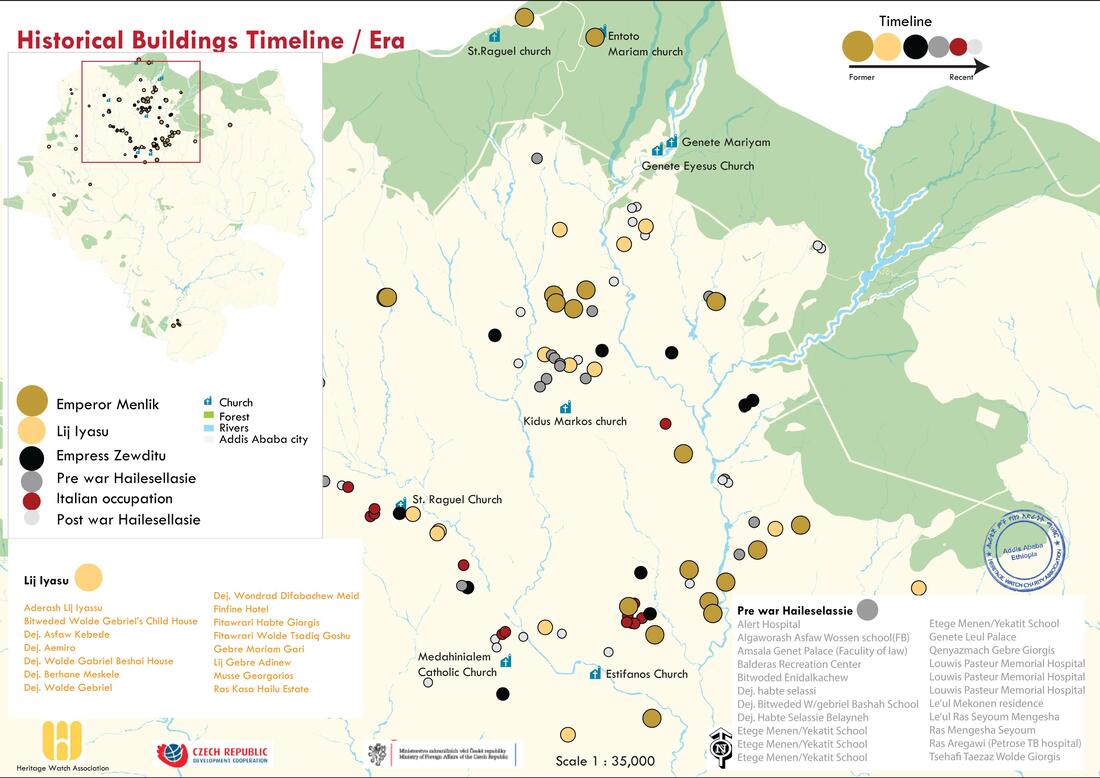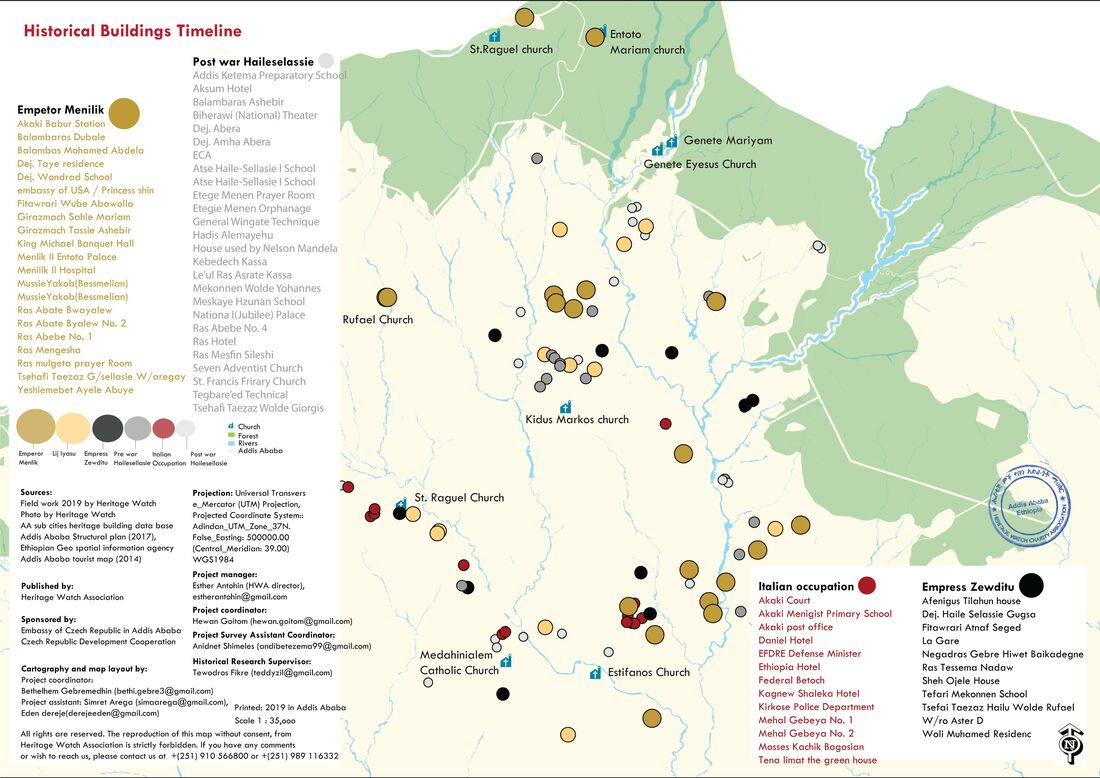In April 2019, with grant support from the Embassy of the Czech Republic in Addis Ababa, HW launched a major architectural survey to address the devaluation of historical buildings in Addis Ababa. While these buildings are in public domain, in truth, they suffer from lack of custodianship and legal protection. Their individual identity and relevance to both Addis Ababa’s and Ethiopia’s history is in danger of being erased for good.
From this work, we have produced detailed maps of each neighborhood of Addis, which includes rich details of attractions such as historical buildings, landmarks and parks.
Browse our collection of maps and photos to learn more about each of the six neighborhoods and download the maps to help you better explore Addis.
Stay tuned for the release of the full, high resolution maps that you can purchase for yourself or as a gift, particularly for Ethiopian educational institutions in need of these resources.
From this work, we have produced detailed maps of each neighborhood of Addis, which includes rich details of attractions such as historical buildings, landmarks and parks.
Browse our collection of maps and photos to learn more about each of the six neighborhoods and download the maps to help you better explore Addis.
Stay tuned for the release of the full, high resolution maps that you can purchase for yourself or as a gift, particularly for Ethiopian educational institutions in need of these resources.
|
Historical maps of Addis Ababa was made possible by a grant from the Embassy of the Czech Republic and Czech Development Agency. Visit our projects for more information.
|
Maps of Addis Heritage Attractions
Addis Ketema Heritage Maps
|
Addis Ketema which translates as the New City, is one of the ten sub-cities of Addis Ababa. As the name states, it is a relatively newer part of the capital city therefore, only a handful of historical buildings are located there. Among the attractions in this area are the residence of Fitawrari Habte Georgis, Mahal Gebeya which translates as middle of the market.
Click here to download Addis Ketema Heritage Maps: Merkato The largest open-market in Africa. |
Arada Heritage Maps |
Arada is the oldest section of Addis Ababa and contains the most fascinating array of historical buildings in all of the capital city. The original center of commerce began around the first hotel in the city, Taitu hotel. When Alfred Ilg, a swiss Engineer and Emperor Menelik's right hand man, built his house a little further down from the hotel, it was one of the few settlements in Arada. The house which still stands today (though in deplorable condition), was a stone's throw away from Menelik Palace with a panoramic view of the palace up the hill, just beyond the Erye Bekentu bridge. Attractions include, Ghandi street ( one of the very few streets in Addis which is entirely made up of historical buildings), the Meteg building and Hagir Fiker Theatre
(the first theatre in Ethiopia) . Click here to download Arada Heritage Maps: Piassa Tomoca Taitu |
Gulele Heritage Maps
|
Gulele is located north of the capital city and adjacent to Entoto Mountain, and the Ethnographic museum, originally known as Gunete Leul Palace. This was originally the palace of Ras Mekonnen Wolde Mikael, father of Emperor Haile-Selassie. Additional attractions include the Tafari Mekonnen school, one of the oldest boys boarding school. The recently demolished, elegant and very unique façade of Dejazmach Asfaw residence was nestled behind a narrow and non- descript street near Etege Menen school.
Click here to download Gulele Heritage Maps: Tafari Mekonnen AAU |
Kirkos Heritage Maps
|
Kirkos is located in the middle (center) of Addis Ababa. This sub city consists of many landmarks and famous historical buildings, which may not necessarily be on the normal tour circuit. These are' Jubilee Palace also known as the National Palace built by and residence of Emperor Haile-Selassie I. The Ethiopia hotel is significant as the place where African dignitaries who attended the first OAU a meeting were staying. The Finfine hotel (1890s) and Ghion hotel (1940s) both offer a piece of Addis's history and with exotic and authentically Ethiopian experiences.
Click here to download Kirkos Heritage Maps: Filwha The famous natural spring water that initially drew Empress Taitu to Addis Ababa. La Gare The Ethio-Djibouti Railway built by the French in 1894 -1917 |
Lideta Heritage Maps
|
Lideta also located in the middle (center) of Addis Ababa is an old neighborhood, which used to be known as Old Airport. This sub city has a good amount of historical buildings although most are institutions and not a draw for tourists. The Lombardi restaurant and Hotel D'Afrique are two attractions worth mentioning.
Click here to download Lideta Heritage Maps: Mexico Square Black Lion Hospital |
Yeka Heritage Maps
|
Yeka is located in north east of Addis Ababa. It is the largest of all 10 sub cities, both in area as well as population. It is also the area that has the most historical buildings in all of the capital city, including all the earliest embassies including the French, English, Italian, Russian and German. All these are listed as heritage entities. Moreover, this area was originally the residences of the nobility for whom the old neighborhood are named. i.e. Ras Seyoum, Ras Kassa and Ras Mulugeta seferoch (neighborhoods). The old imperial stables which were in the area of Baldaras (which means the mules or horses stables) still has retained the name, although this neighborhood is now surrounded by low income apartment buildings.
Click here to download Yeka Heritage Maps: Farensay 41 Eyesus Menelik Hospital |
What to look for when visiting historical homes in Addis Ababa?
Main geographic divisions
Addis Ababa is divided into 10 sub cities of varying sizes and age. It is further divided into 28 woredas a smaller administrative unit than the sub cities. Finally there 330 kebeles in the capital and these are even smaller administrative units and neighborhoods.
Key Historical Eras of Modern Ethiopia
Insert short text that contextualizes the two photos of historical timelines
Main geographic divisions
Addis Ababa is divided into 10 sub cities of varying sizes and age. It is further divided into 28 woredas a smaller administrative unit than the sub cities. Finally there 330 kebeles in the capital and these are even smaller administrative units and neighborhoods.
Key Historical Eras of Modern Ethiopia
Insert short text that contextualizes the two photos of historical timelines
Features of Ethiopian Architecture
These are a few features that make up the unique styles of Addis Ababa homes and buildings:
These are a few features that make up the unique styles of Addis Ababa homes and buildings:
- Timber laced stone construction: framed structures of heavy timber joined by stone, usually horizontally
- Timber laced brick construction: bricks placed in mortar in a systematic manner
- Timber structure construction: heavy timber jointed together with various joints, commonly and originally with lap jointing, and then later pegged mortise and tenon joints. Diagonal bracing is used to prevent "racking", or movement of structural vertical beams or posts.
- Stone masonry construction: structures built from individual units laid in and bound together by mortar. Common materials of masonry construction are bricks, stones, marble, granite, travertine, limestone, cast stone, concrete block, glass block, stucco and tile.
- Hybrid structure: combination of concrete with precast concrete units, such as in situ columns with precast floor slabs.



